Sunrise at Lillydale Lake was serene with dozens of bird species flying overhead, foraging in the bushes, dabbling in the water, waddling amongst the reeds and cackling in the gum trees: it was sad to have such peacefulness marred by the impact of carelessly discarded fishing line.
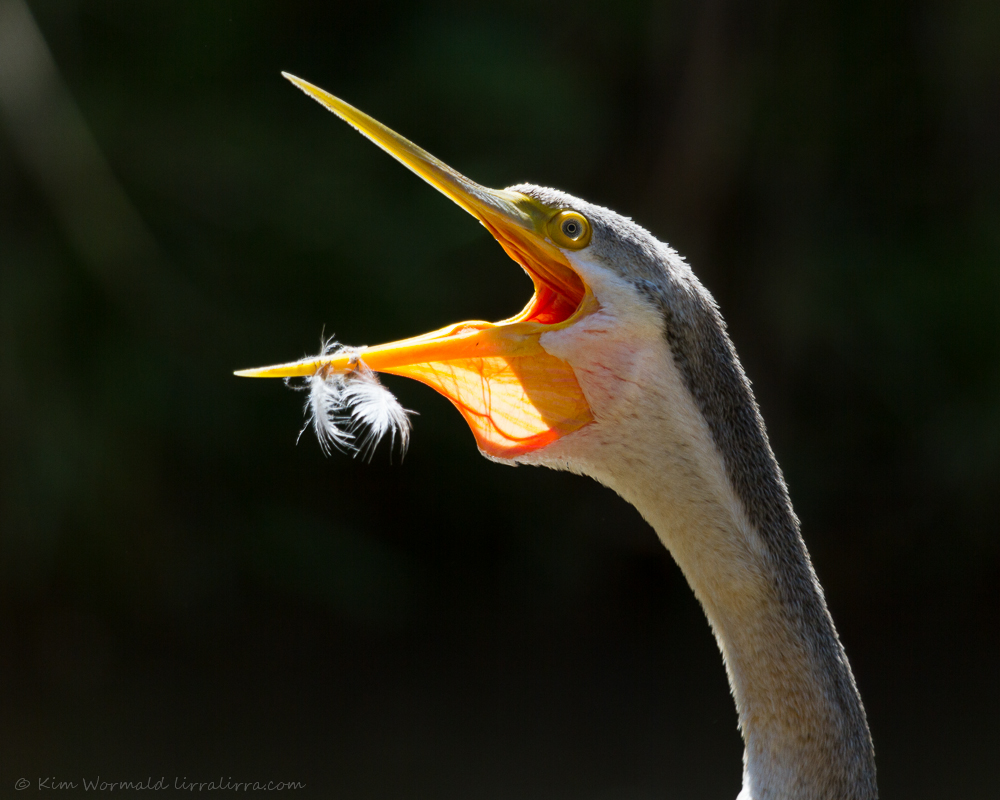
Australasian Darter (Anhinga novaehollandiae)
Canon 7D, 100-400mm L IS USM, 1/640, f/5.6, ISO 200, focal length 390mm
Sometimes serendipity means I can catch a moment like the one in the image above; this darter began calling while I was looking at it through the camera. The sunlight looked amazing shining through its skin and highlighting the spear-like quality of the bill against the dark background. Its call was a guttural “kar kar kakakakaka” that caused its throat to vibrate. It was a beautiful moment. At this point I wasn’t concerned about the feather on her bill, I thought it was from normal preening.
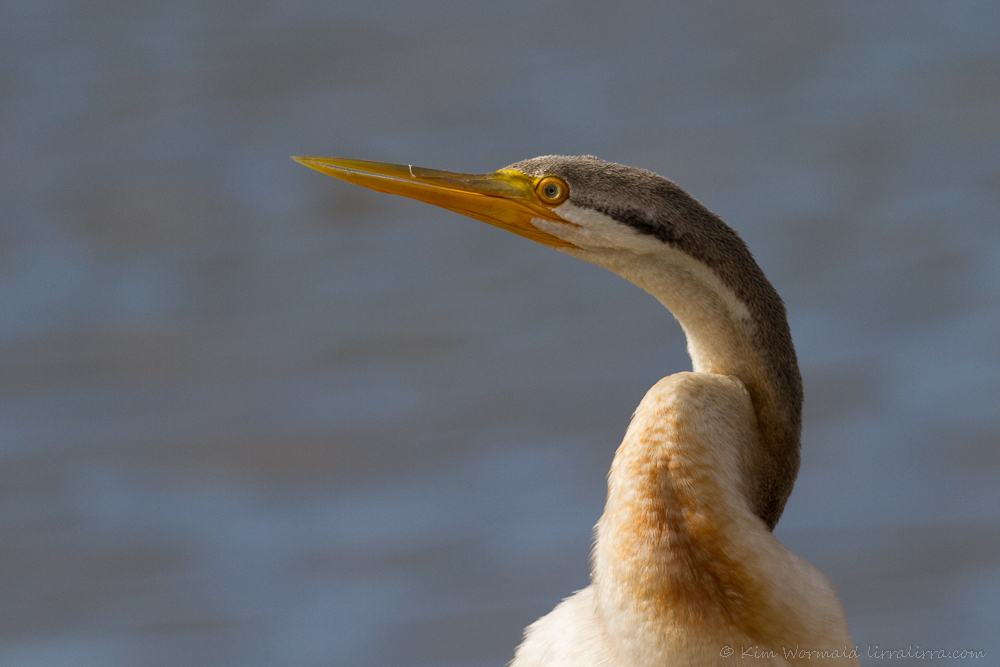 Australasian Darter (Anhinga novaehollandiae)
Australasian Darter (Anhinga novaehollandiae)
Canon 7D, 100-400mm L IS USM, 1/640, f/5.6, ISO 100, focal length 400mm
Several Australasian Darters call Lillydale Lake ‘home’ and have favourite perches on fallen logs, jetties and in trees. Their strongly kinked necks and habit of swimming low in the water has given them the nickname ‘snake bird’. If you look closely you’ll see this bird (photographed last month) has a band of some kind caught on its upper bill which can catch on objects when it dives to spear fish.
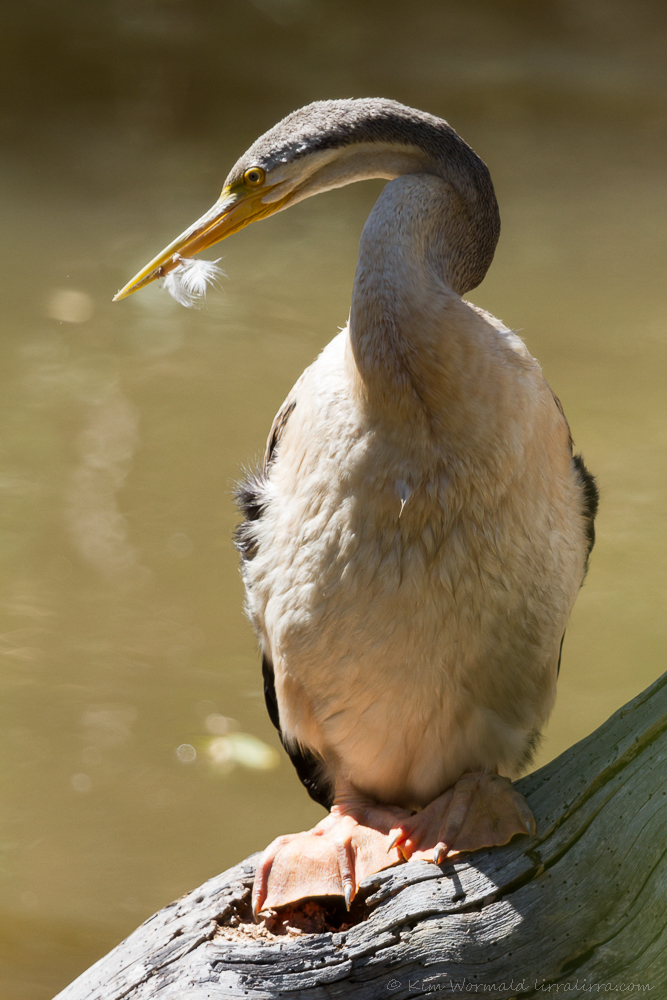 Australasian Darter (Anhinga novaehollandiae)
Australasian Darter (Anhinga novaehollandiae)
Canon 7D, 100-400mm L IS USM, 1/500, f/5.6, ISO 200, focal length 375mm
This darter became irritated by the feather on its lower bill; it wasn’t until I looked at the images on screen that I realised something like a fishing hook or lure is trapping the feather, or maybe it is a fishing lure. On the same day I saw the carcass of a Purple Swamphen hanging from a clump of gumnuts in a eucalyptus tree, trapped by a tangle of fishing wire around its leg.
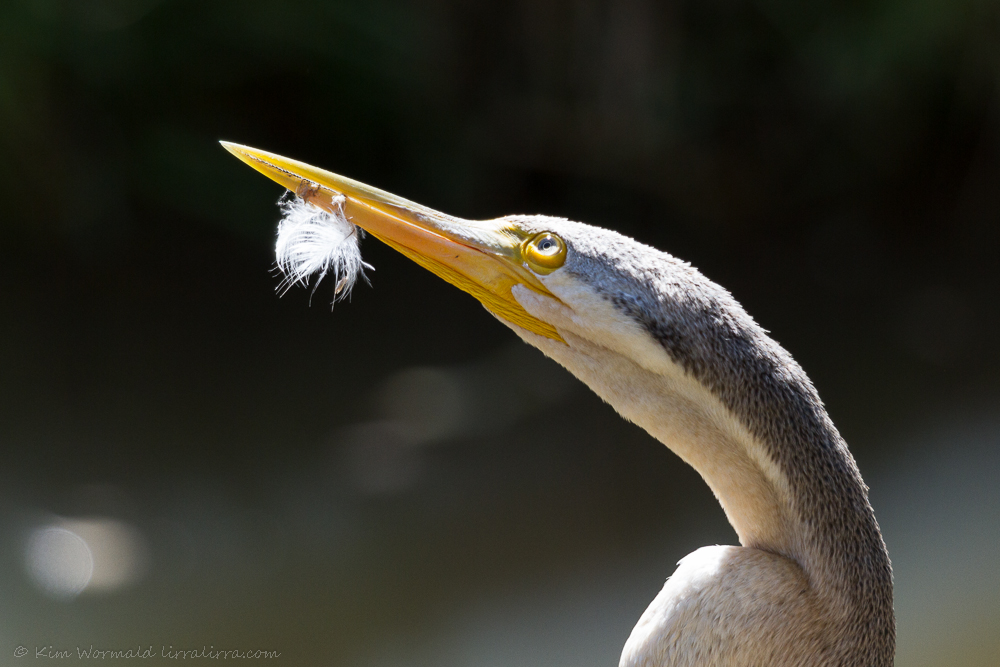 Australasian Darter (Anhinga novaehollandiae)
Australasian Darter (Anhinga novaehollandiae)
Canon 7D, 100-400mm L IS USM, 1/640, f/5.6, ISO 320, focal length 370
I find this image wistful, as though the bird is looking to the heavens for help to remove the foreign object from its bill; though it’s more likely checking out a flock of Little Corellas. Just above the feather, to the right, is a little curve of reflected light that I believe could be part of a fishing hook. I called the shire hoping to speak to a ranger but was asked to contact Wildlife Victoria (which I have done), while the shire contacted the on-site parks coordinator about the possibility of a clean-up. I’m concerned the darter could become trapped while diving.
Lillydale Lake is popular with anglers, next time I visit I’ll look for signage and bins relating to the responsible removal of fishing line. Signage should include a contact number to summon help for wildlife and I’d like to see a list of ways that wildlife can be harmed by discarded fishing equipment, including: drowning, entanglement, movement restriction, amputation, lead poisoning and starvation to help peope understand the potential consequences. Nestlings have also been known to become entangled in fishing line, like the documented case of conjoined robins in the USA.
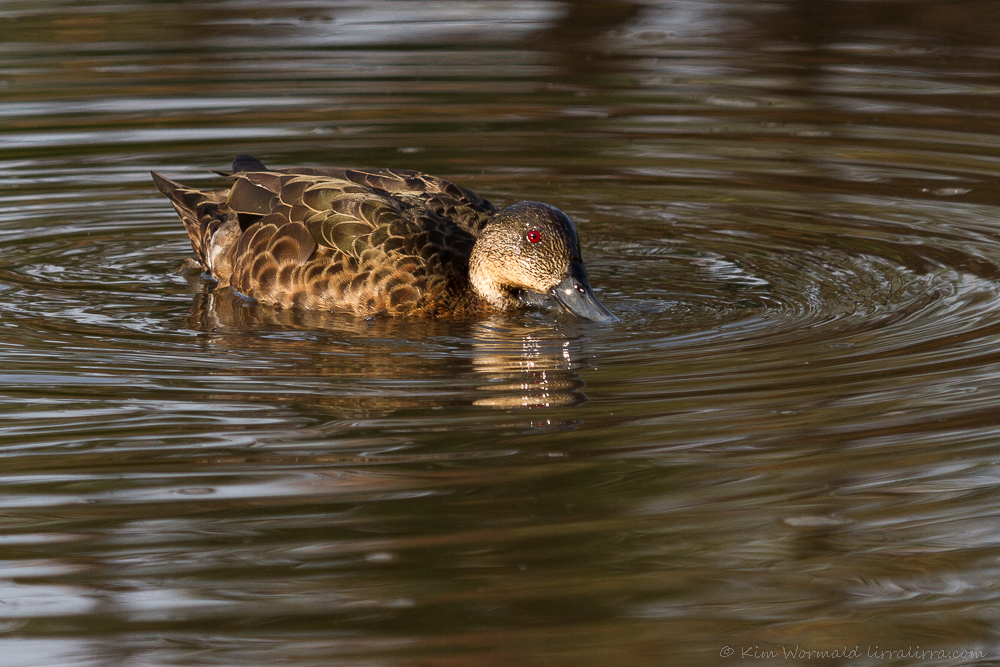 Chestnut Teal (Anas castanea) (male eclipse)
Chestnut Teal (Anas castanea) (male eclipse)
Canon 7D, 100-400mm L IS USM, 1/400, f/5.6, ISO 125, focal length 220mm
I thought this was a Grey Teal initially as the colours were muted and sunlight was catching the pale throat but there is too much chestnut in the plumage. Male Chestnut Teal can become quite dull when not in breeding plumage but I am surprised his head isn’t darker or showing any sign of its usual deep green colour.
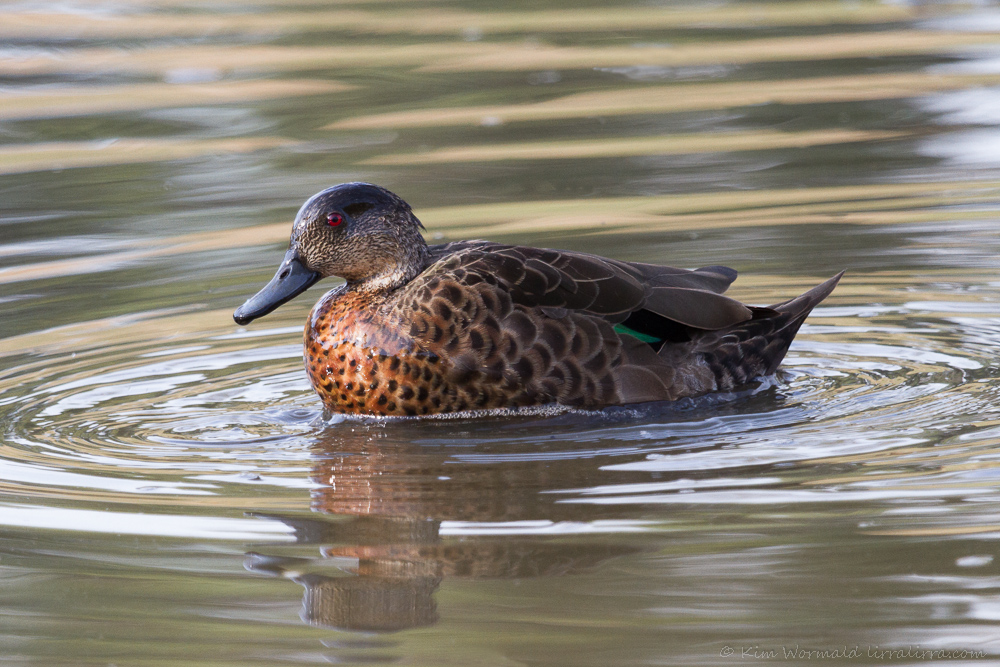 Chestnut Teal (Anas castanea)
Chestnut Teal (Anas castanea)
Canon 7D, 100-400mm L IS USM, 1/500, f/5.6, ISO 640, focal length 370mm
It was fun to watch the teal move closer to the grassy clump I was nestled into at the edge of the pond. Occasionally it rose up in the shallow water to use its feet to paddle the bottom of the pond before ducking under for another feed. I like the sheen of water over the teal and the bubbles it created as it dabbled.
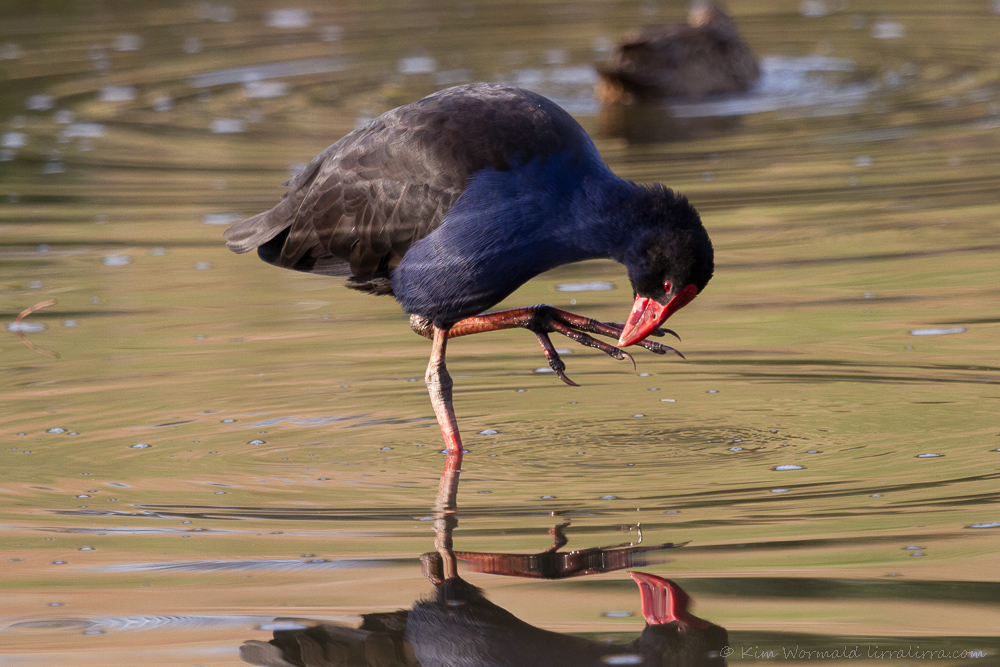 Purple Swamphen (Porphyrio porphyrio)
Purple Swamphen (Porphyrio porphyrio)
Canon 7D, 100-400mm L IS USM, 1/640, f/5.6, ISO 400, focal length 360mm
Purple Swamphens are strange looking birds and this one is no exception!
I was at Lillydale Lake at sunrise twice this week with pleasant company and I was reminded of the quote, “Make new friends but keep the old, one is silver and the other gold”.
When you are out and about enjoying nature keep an eye open for discarded fishing equipment and smile as you remove it from the wild as you will have averted untold suffering.
Happy birding, Kim

hi kim
at my turn, i m glad to dicover your website, this last serie is impressive, the first protrait with feathers on beck are very interesting expressive and unusual, well play kim, see you soon ☺
Hi Eric, thank you for visiting and for your email, very much appreciated 🙂
Kim, I hope that someone is able to help the darter. I see birds with hooks and fishing line more and more often and it is very sad for the birds.
Hi Mia, I’m sorry you’re seeing more issues with birds and fishing lines/hooks, it really is sad. Today I found images of platypus tangled in the horrid stuff. Wildlife Victoria caught a swan and removed a hook from its wing so I’m hoping we’ll be able to help the darter.
Kim, what a lovely blog and I enjoyed your birds and post. The photos are amazing. I do feel sorry for the darter with the object in its mouth. I hope it gets some help. Thanks for the visit and comment. Have a happy weekend!
Thank you Eileen, I’m glad you enjoyed your visit, thank you for letting me know 🙂 I’m trying to get help for the darter but it’s tricky as it can still fly, I’m hopeful that we’ll be lucky.
What happened to the darter? Can you let us know?
No worries Meg. I’ve had conversations with rescuers and shire officers today so hopefully we’ll be able to sort something out, and get signage in place too. Thanks for caring.